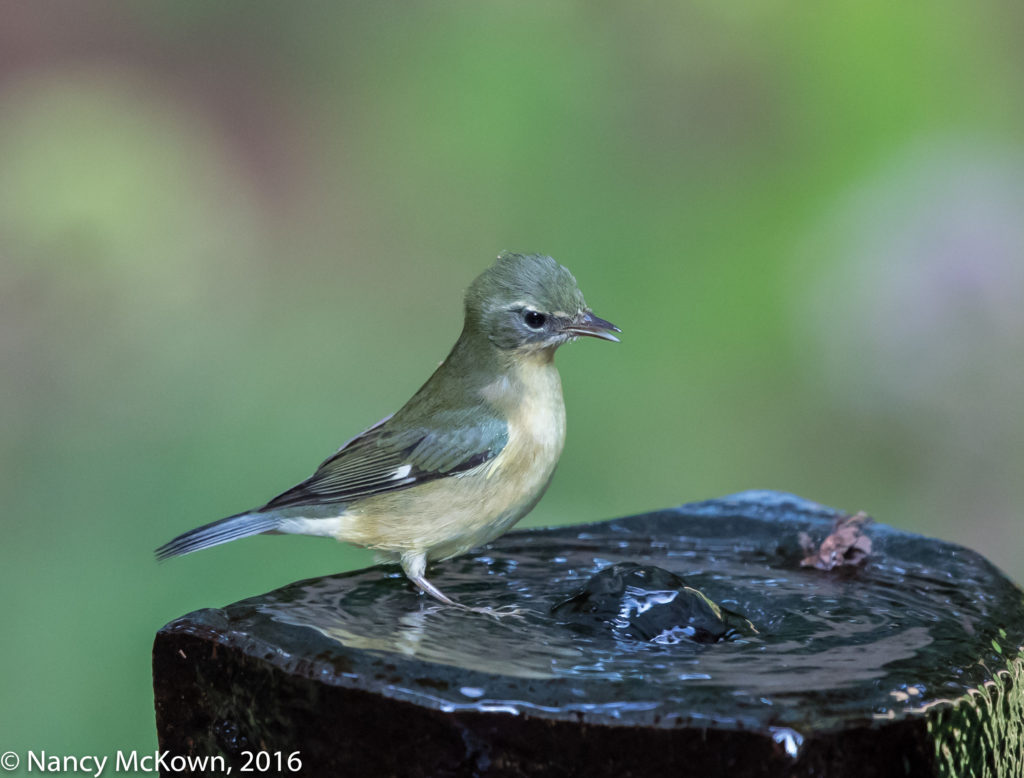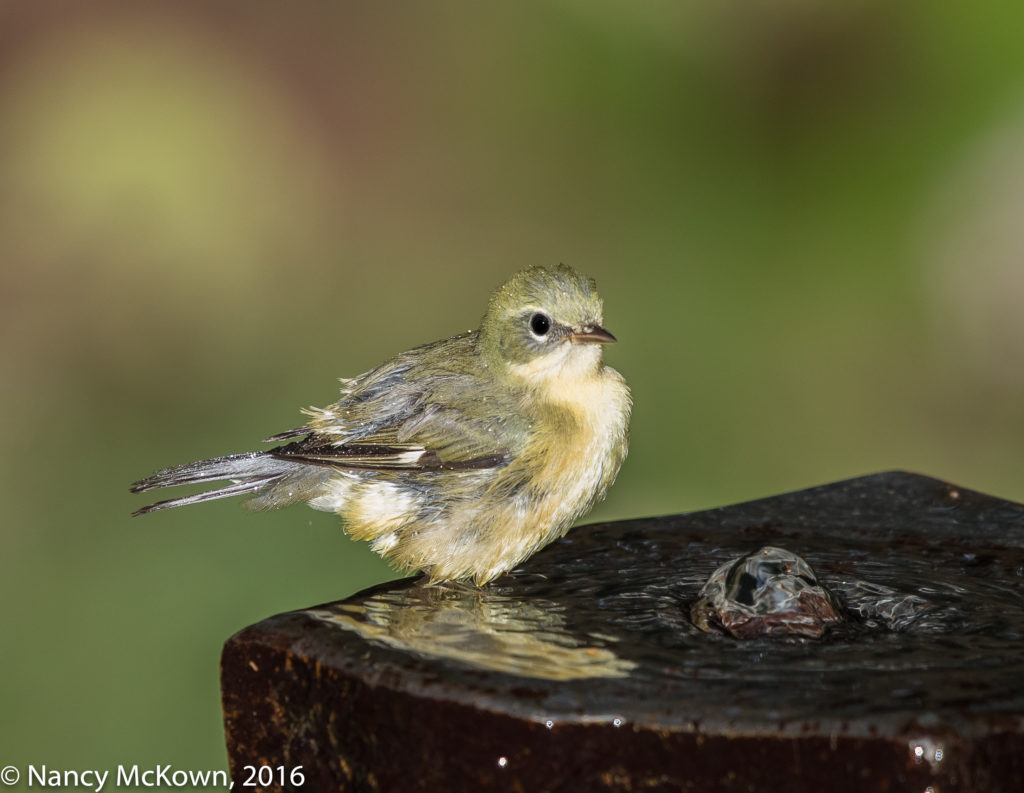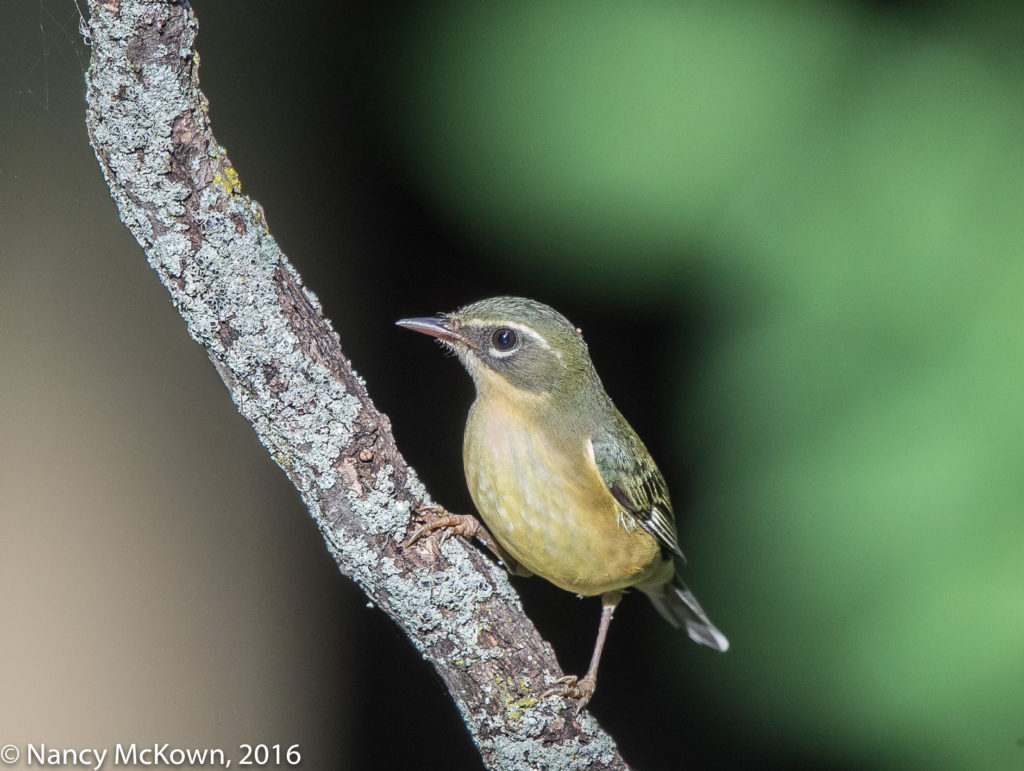Photographing a Female Black Throated Blue Warbler
First cool day we’ve had in a long time. The mosquitoes seem to be taking a break as well. The camera, 500mm lens, 1.4 extender, flash with better beamer extender, and extra battery power pack are all setup on a tripod at the patio door opening to the deck. One leg of the tripod is on the wood deck platform, but most of this ensemble (including me) are in the house.
It’s one of those “happy to be alive” sunny days. The cicada and bird song intermix agreeably with the ringing chimes in the front yard. I have high hopes today because so far this Fall, I’ve seen and photographed 13 species of warblers who have interrupted their journeys south to rest and replenish in our yard. (See Flickr 2016 Fall Migration Album.)

No Telephoto Flash
Pleasing ambient light color tones, but the High ISO value
makes details less distinct.
ISO3200; f/6.3; 1/400 Second
My Canon DSLR camera was set to Al Servo mode for these photos of the female Black Throated Blue Warbler. I activated a splattering of center based auto focus points. Same day, same time, but distinctly different color tones coming through. Different colors are a consequence of the type and intensity of the light. Hard to predict what colors tones will come through with flash… but it is easy enough to correct what you don’t like in post processing by experimenting with the white balance options. NOTE: The color balance for all of these photos was not changed in post processing….and appear “as shot”.

Taken with Telephoto Flash Extender.
More gold tones in this shot.
Enlarge the above photo
to View how the Low ISO Setting
Brings out the Details.
ISO400; f/6.3; 1/250 Second
Matching Auto Focus Mode with Shooting Conditions
So many issues and conditions impact the ability of the camera and lens to precisely focus. As long as the light is good and one or more autofocus points are able to lock focus on the target, you can expect accurate focus, no matter what autofocus mode is set on the camera.
If all of the DSLR autofocus modes work great, why not pick one and stick with it- or better yet, let the camera decide?
Because when you are dealing with high level of subject unpredictability, anything can happen. A fast and responsive lens is designed to achieve the sharpest auto focus when you match shooting conditions with camera’s auto focus modes.
Canon’s Auto Focus Modes
Here is a quick description of the auto focus mode choices available in modern DSLR Canon cameras.
1) One Shot…. for use when your subject is mostly stationary. Once the camera achieves focus, the shutter will release- and NOT before. Perfect for portraits and landscapes where conditions tend to be more predictable. (NOTE: The focusing assist beam on the flash gun that bounces light to the subject and then back to the camera to gauge distance and aid focusing will only work in One Shot mode.)
2) Al Servo…. continually tracks, readjusts and re-focuses until the shutter is pressed down completely. This is the most reliable auto focus mode to capture images of birds on the move. Al Servo places the camera in charge of responding to movement, as long as photographer adeptly tracks the action with activated autofocus points.
3) AI Focus….. the photographer relies on the camera to determine if there’s movement at the time the shutter is released. I don’t find much use for Al Focus mode. I trust Canon cameras to make critical focusing decisions with regard to autofocus points – but not to decide what autofocus mode fits the activity level in a scenario that is likely to be constantly changing.
NOTE: You can turn off auto focus on the lens and focus manually. The auto focusing technology built into modern cameras and lenses is so accurate that even in diminished light, I rarely set the lens to Manual focus.

No Flash.
ISO3200; f/6.3; 1/400 Second
Back Button Focus
When you set your DSLR camera to Al Servo continuous focusing mode you have to keep that shutter button half-engaged to achieve focus. This is highly inefficient, especially when you are tracking lots of action. The Back Button focus function allows you to disengage the shutter button from the focusing function, thus making focusing faster and more precise. To do this, simply focus on your subject by holding down the back focus button with your thumb and get ready to press the shutter release with your fore finger when the peak action starts. The camera will continually focus on the subject, and the shutter will not try to engage focus before taking the photo. Once the subject stops moving, let go of the back button focus and use the shutter button to focus as you did before.
My Preferences
I use Al Servo focus (combined with back button focus) most of the time because this mode puts the lens on the alert for movement. Designed to work hand-in-hand with whatever focus points are activated, it efficiently adjusts and readjusts focus the second it senses motion. Al servo is also essential for panning (following a moving subject) and for bursting.
Read about the difference between shooting modes and autofocus modes here.









you are definitely getting good return on your water feature Nanc!